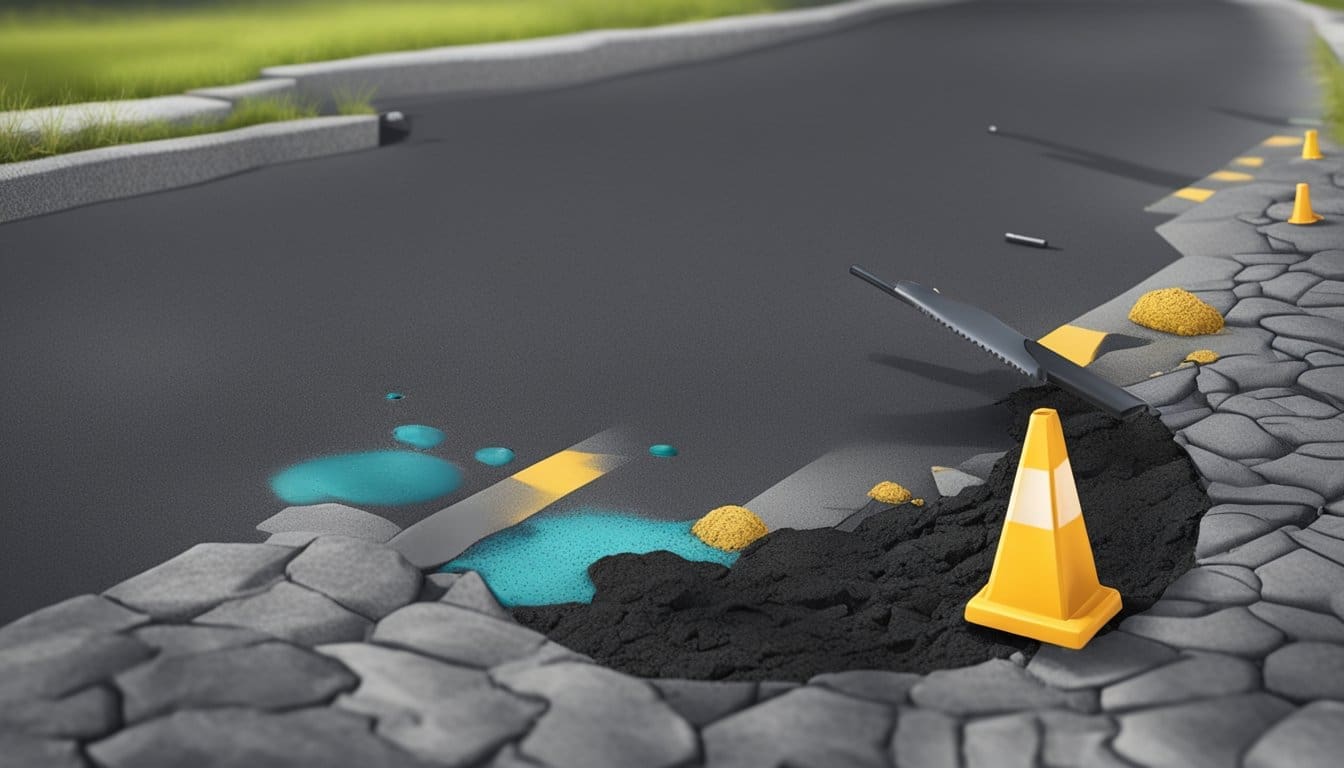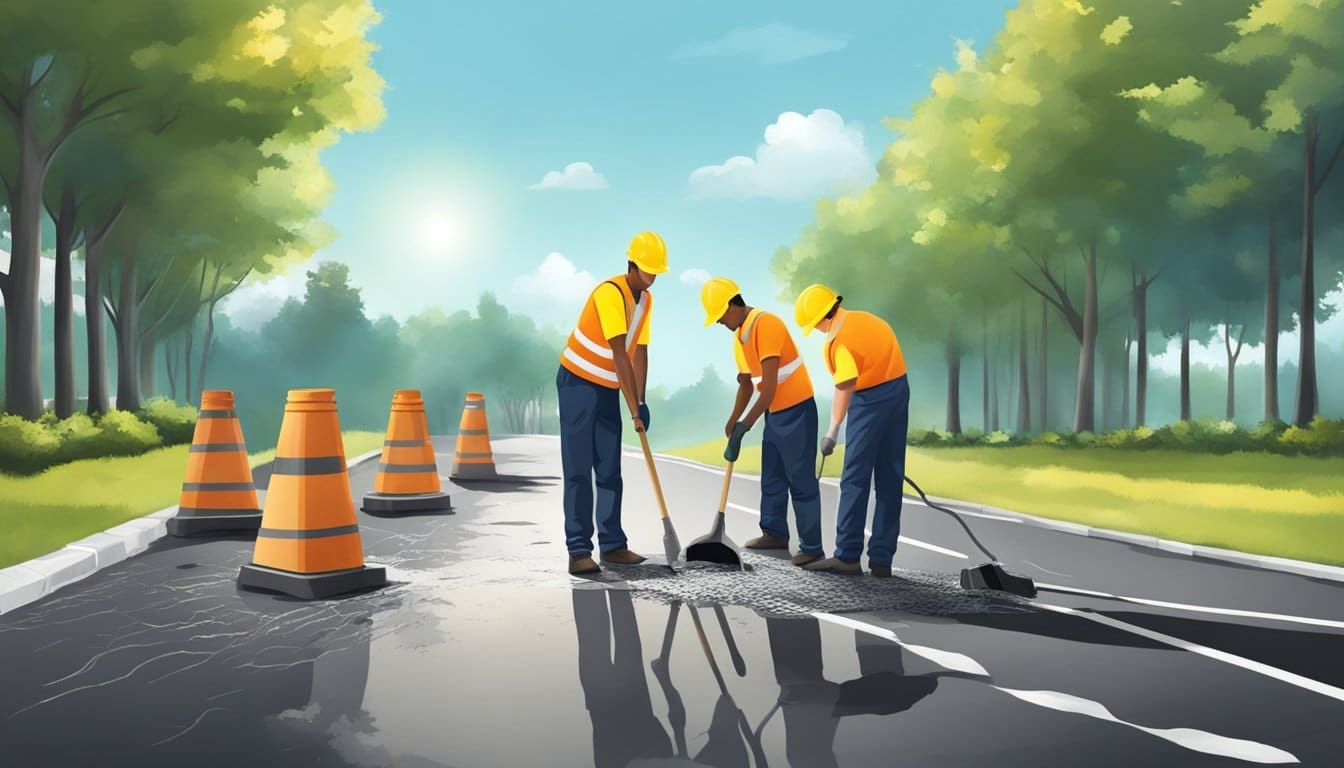All About Asphalt Cracks and Potholes
Road Hazards You Need to Know
Cracks and potholes are common issues that plague asphalt surfaces. You’ve probably driven over them or seen them in parking lots. These problems can start small but quickly grow into major headaches for drivers and property owners.
Cracks in asphalt pavement can lead to potholes if left untreated. Water seeps into these cracks, especially during cold weather. When it freezes, it expands and weakens the asphalt. As cars drive over these weak spots, potholes form.
Fixing cracks and potholes early is key. Small repairs can prevent big problems down the road. Regular maintenance of asphalt surfaces helps them last longer and stay safer for everyone who uses them. You’ll learn more about different types of cracks, how potholes form, and ways to fix them in this article.
Identifying Different Types of Asphalt Damage

Asphalt damage comes in many forms. Knowing how to spot different issues can help you keep your pavement in good shape. Let’s look at some common types of damage you might see.
Understanding Cracks: From Alligator to Transverse
Cracks in asphalt can take various shapes. Alligator cracking looks like a reptile’s skin and often means the pavement base is weak. You’ll see it spread across large areas.
Transverse cracks run across the road. They usually happen because of temperature changes. These cracks can let water in, which causes more damage when it freezes.
Longitudinal cracks go along the road’s length. They might start small but can grow bigger over time. Block cracks form square patterns and are caused by the asphalt shrinking.
To spot these cracks early, look for thin lines on the surface. Catching them quickly can save you money on repairs.
The Making of a Pothole: Causes and Consequences
Potholes are one of the most noticeable asphalt problems. They form when water gets into cracks and freezes. As it expands, it breaks up the pavement.
The freeze-thaw cycle is a big cause of potholes. Water seeps in, freezes, expands, and then melts. This process weakens the asphalt over time.
Traffic makes potholes worse. As cars drive over weak spots, the pavement breaks apart. Soon, you’ve got a hole that can damage vehicles and cause accidents.
Fixing potholes quickly is key. If you see one starting to form, it’s best to repair it right away. This can stop it from growing larger and more expensive to fix.
Other Common Defects: Ravelling, Rutting, and Depressions
Ravelling happens when the top layer of asphalt starts to come loose. You’ll see small rocks and gravel breaking free from the surface. This can make the road rough and uneven.
Rutting creates long dips in the road where tires usually go. It’s caused by heavy traffic pushing down on soft asphalt. You might notice your car pulling to one side in rutted areas.
Depressions are shallow dips in the pavement. They can collect water, which leads to more damage. Look for puddles that don’t drain after rain.
These issues often start small but can get worse fast. Regular checks of your asphalt can help you catch them early. Fixing small problems can prevent bigger, more costly repairs later on.
Maintaining and Repairing Your Asphalt

Taking care of your asphalt is key to making it last. Regular upkeep and quick fixes can save you money and keep your pavement looking great.
Crack Filling and Sealing: Preserving the Pavement
Crack sealing and crack filling is a must for asphalt care. Start by cleaning out any dirt or plants in the cracks. You can use a wire brush or pressure washer for this job.
Next, grab some crack filler. For small cracks, use a caulking gun to apply it. Bigger cracks might need a pour pot. Make sure to fill the crack completely.
After filling, smooth out the surface. A putty knife works well for this. Let it dry fully before you drive on it.
Sealing cracks stops water from getting in. This helps prevent bigger issues down the road. It’s a simple job you can often do yourself.
Pothole Patching: Temporary and Permanent Solutions
Potholes need quick action. For a fast fix, try cold patch. It’s easy to use and sets quickly.
- Clean out the pothole
- Fill it with cold patch
- Compact it with a hand tamper
For a lasting fix, you’ll want a hot mix. This job is tougher and often needs pro help. The steps are:
- Cut around the pothole
- Remove loose material
- Apply a tack coat
- Fill with hot asphalt
- Compact thoroughly
Both methods work, but hot mix lasts longer. Choose based on your needs and skills.
Preventative Measures and Timely Interventions
Regular checks of your asphalt can catch problems early. Look for small cracks or spots that hold water. These are signs you need to act.
Seal coating every 2-3 years helps a lot. It adds a protective layer to your asphalt. This job is best left to pros for the best results.
Keep your asphalt clean. Sweep it often and clean up spills fast. Oil and gas can damage the surface if left too long.
In winter, be careful with salt. It can harm asphalt. Try sand or kitty litter for traction instead. Quick snow removal also helps prevent damage from freeze-thaw cycles.
Factors Affecting Asphalt Longevity

Asphalt durability depends on several key factors. Weather, drainage, and aging all play crucial roles in how long your asphalt surface will last.
Impact of Weather and Temperature Changes
Weather conditions can really affect your asphalt’s lifespan. Hot summers and cold winters take a toll. When it’s hot, asphalt can get soft and form ruts. Cold weather makes it crack.
Freeze-thaw cycles are tough on asphalt. Water seeps into tiny cracks, then freezes and expands. This makes the cracks bigger. Over time, small cracks turn into big problems.
UV rays from the sun also damage asphalt. They dry it out and make it brittle. This leads to more cracking and faster aging.
To protect your asphalt:
- Use sealcoating every few years
- Fix small cracks quickly
- Keep the surface clean
The Role of Proper Drainage
Good drainage is key for long-lasting asphalt. When water sits on the surface, it causes big issues.
Poor drainage leads to:
- Weakened base layers
- Potholes
- Cracks
- Faster breakdown of the asphalt
You need to make sure water can flow off your asphalt easily. Slope the surface slightly. Install drains if needed. Keep gutters and storm drains clear.
Check for low spots where water pools. Fill these in to prevent damage. Also, look for areas where water might be coming onto the asphalt from nearby. Redirect this water if possible.
Asphalt Aging: Durability Through the Years
Asphalt doesn’t last forever. It starts to break down as soon as it’s laid. But with good care, you can make it last longer.
Fresh asphalt is dark and flexible. As it ages, it gets lighter and more brittle. UV rays and oxidation cause this aging process.
Signs of aging asphalt:
- Fading color
- Small cracks
- Rough texture
You can slow down aging by:
- Asphalt Sealcoating every 2-3 years
- Fixing damage quickly
- Keeping the surface clean
With proper care, your asphalt can last 15-20 years. Regular maintenance is cheaper than replacing the whole surface.
Opting for Overhaul: Resurfacing and Reconstruction

When your asphalt shows signs of wear, you have two main options: resurfacing or full reconstruction. These approaches can breathe new life into damaged pavement and extend its lifespan.
When to Consider Resurfacing Your Asphalt
Resurfacing is a good choice when your asphalt has surface damage but a solid foundation. This process involves applying a new layer of asphalt over the existing surface. It’s cheaper and faster than full reconstruction.
Before resurfacing, crews will fix cracks and potholes. They’ll also clean the surface to ensure the new layer sticks well. The fresh asphalt layer is usually 1.5 to 3 inches thick.
Resurfacing works best for pavements with:
- Minor cracks
- Slight unevenness
- Faded or worn surfaces
It’s not suitable for pavements with deep structural issues. If you see large cracks or sinking areas, you might need a bigger fix.
The Road to Reconstruction: Starting From Scratch
When damage goes deep, reconstruction is your best bet. This means tearing out the old pavement and starting over. It’s more expensive and time-consuming, but it solves problems at their root.
Reconstruction involves several steps:
- Removing the old asphalt
- Fixing the base layers
- Laying new asphalt
You should think about reconstruction if you see:
- Deep cracks or alligator cracking
- Frequent potholes
- Sinking or uneven areas
Reconstruction gives you a chance to improve drainage and fix underlying issues. It’s a big job, but it results in a pavement that can last 20-30 years with proper care.
Frequently Asked Questions

Asphalt cracks and potholes can be a real pain. Let’s tackle some common questions about fixing and preventing these pesky road problems.
How do you fix asphalt cracks before they turn into potholes?
To fix cracks, clean them out first. Use a wire brush to remove debris. Then fill the cracks with a crack sealant. This keeps water out and stops the cracks from getting bigger.
Apply the sealant on a dry day. Make sure it’s not too hot or cold outside. Smooth it out and let it dry completely.
What are some effective asphalt patching techniques?
For small holes, use cold patch asphalt. Clean out the hole and fill it slightly above the surface. Tamp it down firmly.
For bigger holes, cut out a square around the damaged area. Fill it with hot mix asphalt. Compact it well with a plate compactor or roller.
What’s the best way to get cold patch asphalt to set properly?
Prep the area well. Clean out all loose bits. Apply the cold patch in thin layers. Compact each layer before adding the next.
Use a hand tamper or plate compactor to press it down firmly. The more you compact it, the better it will set and last.
Can you just slap new asphalt over an old, cracked surface?
Nope, that’s not a good idea. The cracks will just come back through the new layer. You need to fix the underlying issues first.
Repair cracks and holes before resurfacing. Make sure the base is solid. If not, you might need to dig it up and start fresh.
How long can you expect a cold patch asphalt repair to hold up?
Cold patch is a temporary fix. It might last a few months to a year, depending on traffic and weather. It’s not meant to be permanent.
Use it for quick repairs in winter or emergencies. For a long-lasting fix, plan to replace it with a hot mix asphalt patch later.
What are the top causes behind potholes forming in the road?
Water is the main culprit. It seeps into cracks, then freezes and expands. This breaks up the asphalt.
Heavy traffic and poor drainage make it worse. Thin asphalt or a weak base can also lead to potholes. Regular maintenance helps prevent them.






